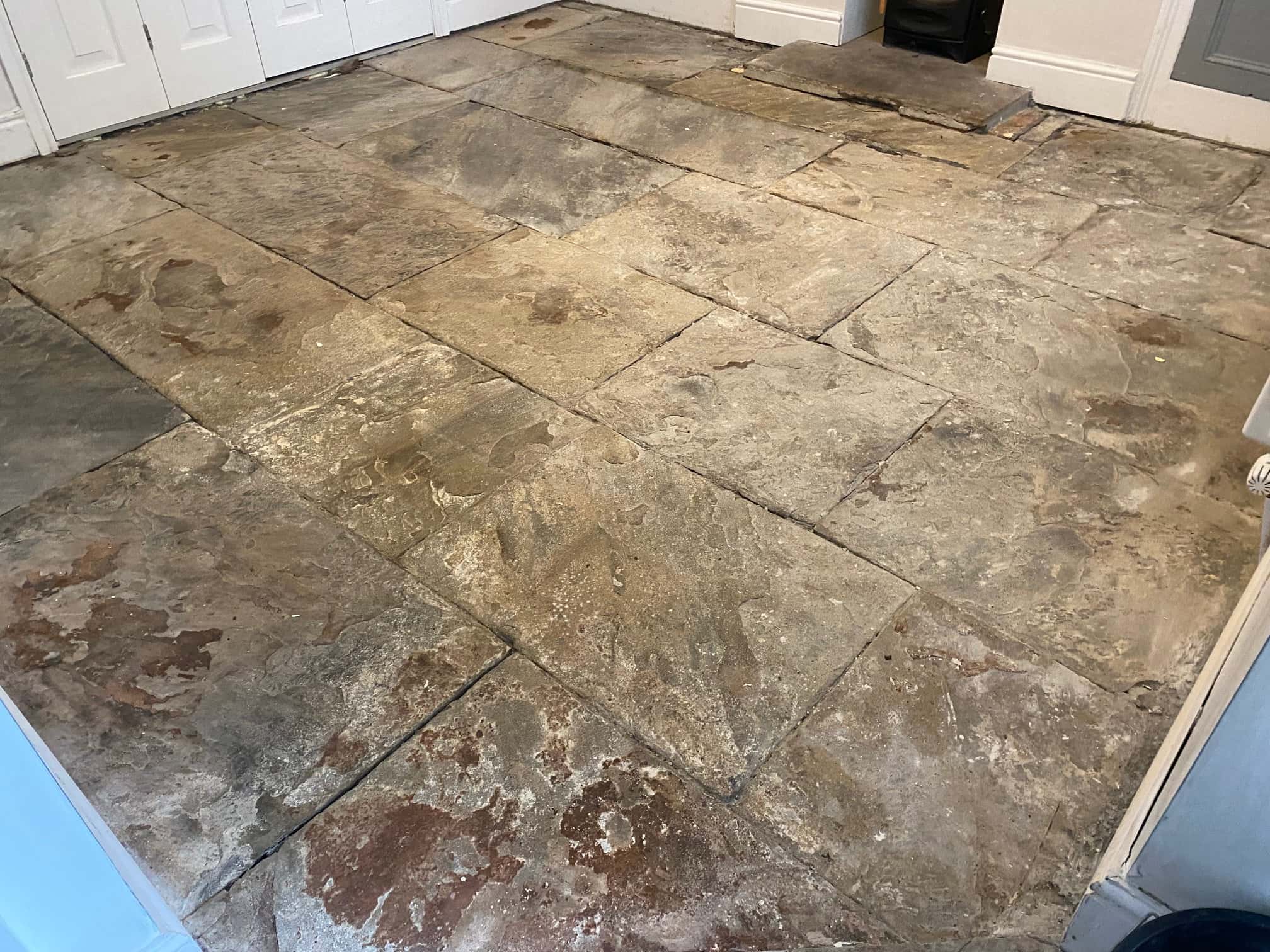The pictures below are of a 12m2 Sandstone Flagged floor at a property in Prestonwere the surface of the stone was flaking off. The floor looked terrible and more importantly my customer mentioned that visitors had occasionally tripped on the uneven stone, and this was causing some concern.

The most likely cause of the surface flaking or shaling was due to water damage at some point in the stone’s history and probably well before the flagstones were laid. However here at Tile Doctor we have developed a solution for this problem called Milling. The process involves applying very abrasive floor pads to the stone in order cut back approximately 3 to 5mm of damaged stone from the top of the slab to reveal a fresh surface underneath. Essentially it will reface the stone and, in the process remove heavy lippage to leave a smoother beautiful surface that is easier to clean and maintain.
Another job which we agreed to do was to knock out the old pointing (what there was of it) and apply fresh. With the Sandstone flagstones smoothed, new pointing and stone sealed the floor was going to be transformed and unrecognisable once completed.
Milling a Flaking Sandstone Flagged Floor
Milling Sandstone flagstones involves the use of a set of thee coarse millings pads of different grades (50, 100 and 200 grit). They are applied to the stone in sequence beginning with the 50-grit pad and applied using a weighted heavy duty floor buffer. This generates a lot of dust, so water is used to lubricate and keep the dust down. During the process the water turns into a murky brown slurry which needs to be rinsed off and extracted using a wet vacuum as you go.
With the shaling removed it was then a question of polishing up the surface of the stone with the finer 100 and then 200-grit milling pads. Again, water is used to lubricate and capture the dust created during the process and then rinsed away and extracted with the wet vacuum.

The process successfully managed to remove all the flaking material, flatten out the lippage and remove the unappealing surface.
When it comes to repointing old flagstone floors, I find a lot of builders and tilers I speak to usually recommend Limecrete or similar which is staple for old floors as its breathable, but I find it difficult to work with and it takes a long time to cure fully. Another problem is every time the floor is given a decent clean, some of the White Limecrete rinses out and into the stone.
Personally, I like to use a German product called VDW800, its fully breathable, has a reliable working time, its easy to apply and does a great job. I’ll put a link to a video about it in this post so you can see how to use it. It’s not a Tile Doctor product but I’m more than happy to endorse it.

Sealing Flagstone Floor Tiles
The stone and fresh mortar was left to dry out for 48 hours to ensure it would be dry before completing the last stage of applying a sealer. Before starting with sealing, I gave the floor light clean to remove any loose mortar from the pointing.
One done I sealed the sandstone using several coats of Tile Doctor Colour Grow, which is an impregnating product that soaks into the pores of the stone and occupies that space preventing dirt from become ingrained. Colour Grow as its name suggests also improves the appearance of the stone by enhancing its natural colours. The sealer also leaves a matt finish, which is a perfect match for the rustic character of the old stone.

For aftercare I recommend using a pH neutral tile cleaner such as Tile Doctor Neutral Tile Cleaner, many supermarket products are very strong and contain bleach, using something like that on a sealed floor will reduce the life of the sealer.



Tile Doctor is the only Tile, Stone and Grout cleaning service in the UK on Trustpilot and with a 4.7 Star rating based on over 1,100 verified customer feedbacks you can be certain you’re in good hands.